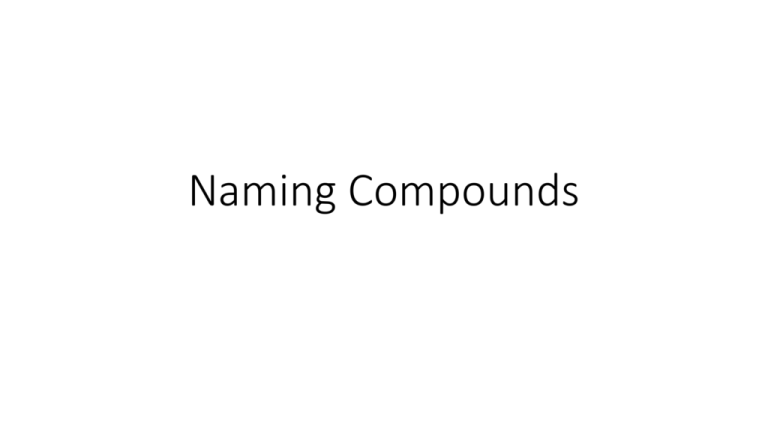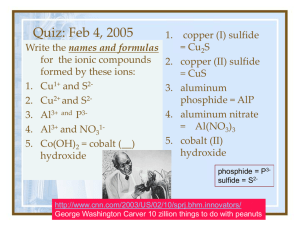
Naming Compounds
Binary Compounds are composed of two types of
elements such as H2O or KBr, not necessarily
just two atoms. Diatomic molecules consist of
two atoms of the same type such as H2 and O2.
1. Binary Ionic Compounds
Metal—nonmetal such as NaCl and CaCl2.
2. Binary Covalent Compounds
Nonmetal—nonmetal such as H2O and CO2
2
•
Binary ionic compounds
contain positive cations
and negative anions.
Type I compounds
•
Metal present forms
only one cation.
Type II compounds
•
Metal present can
form 2 or more
cations with different
charges.
Copyright © Cengage Learning. All rights
reserved
3
Type I Compounds
Metals (Groups I, II, and III) and Non-Metals
Metal _________
Sodium
+ Non-Metal _________ide
Chlorine
Sodium Chloride NaCl
Metal _________
Calcium + Non-Metal _________ide
Bromide
Calcium Bromide CaBr2
Aluminun + Non-Metal _________ide
Oxide
Metal _________
Aluminum Oxide Al2O3
Common Simple Cations and Anions
Copyright © Cengage Learning. All rights
reserved
5
Rules for Naming Type I Ionic Compounds
1. The cation is always named first and the anion
second.
2. A simple cation takes its name from the name
of the element.
3. A simple anion is named by taking the first part
of the element name (the root) and adding –
ide.
Copyright © Cengage Learning. All rights
reserved
6
Binary Ionic Compounds (Type I)
•
Examples:
KCl
Potassium chloride
MgBr2Magnesium bromide
CaO
Copyright © Cengage Learning. All rights
reserved
Calcium oxide
7
Exercise
What is the name of the compound SrBr2?
a)
b)
c)
d)
strontium bromine
sulfur bromide
strontium dibromide
strontium bromide
Copyright © Cengage Learning. All rights
reserved
8
Binary Ionic Compounds (Type II) with
Transition
Metals
• Metals in these
•
•
•
compounds can form
more than one type of
positive charge.
Charge on the metal ion
must be specified.
Roman numeral indicates
the charge of the metal
cation.
Transition metal cations
usually require a Roman
numeral.
Copyright © Cengage Learning. All rights
reserved
9
Type II Compounds
Metals (Transition Metals) and Non-Metals
Metal ______
Iron +Roman Numeral (__)
III + Non-Metal ________ide
Bromine
Iron (III) Bromide FeBr3
Compare with Iron (II) Bromide FeBr2
Metals (Transition Metals) and Non-Metals
Older System
Metal (Latin) _______
Ferrous + ous or ic + Non-Metal ________ide
Bromine
Ferrous Bromide FeBr2
Compare with Ferric Bromide FeBr3
10
Common Type II Cations
11
Rules for Naming Type II Ionic Compounds
1. The cation is always named first and the
anion second.
2. Because the cation can assume more than
one charge, the charge is specified by a
Roman numeral in parentheses.
Copyright © Cengage Learning. All rights
reserved
12
Binary Ionic Compounds (Type II)
•
Examples:
CuBr
Copper(I) bromide
FeS
Iron(II) sulfide
PbO2
Lead(IV) oxide
Copyright © Cengage Learning. All rights
reserved
13
Exercise
What is the name of the compound CrO2?
a)
b)
c)
d)
chromium oxide
chromium(II) oxide
chromium(IV) oxide
chromium dioxide
Copyright © Cengage Learning. All rights
reserved
14
Exercise
What is the correct name of the compound that
results from the most stable ion for sulfur and the
metal ion that contains 24 electrons?
a)
b)
c)
d)
iron(III) sulfide
chromium(II) sulfide
nickel(III) sulfate
iron(II) sulfide
Copyright © Cengage Learning. All rights
reserved
15
Rules for Naming Type III Binary Compounds
• Formed between two nonmetals.
1. The first element in the formula is named
first, and the full element name is used.
2. The second element is named as though it
were an anion.
3. Prefixes are used to denote the numbers of
atoms present.
4. The prefix mono- is never used for naming the
first element.
Copyright © Cengage Learning. All rights
reserved
16
Type III Compounds
Non-Metals and Non-Metals
Use Prefixes such as mono, di, tri, tetra, penta, hexa, hepta, etc.
CO2 Carbon dioxide
CO Carbon monoxide
PCl3 Phosphorus trichloride CCl4 Carbon tetrachloride
N2O5 Dinitrogen pentoxide
CS2 Carbon disulfide
17
Prefixes Used to
Indicate Numbers in
Chemical Names
18
Additional Prefixes
9
nona-
10
deca-
11
undeca-
12
dodeca-
13
trideca-
14
tetradeca-
15
pentadeca-
16
hexadeca-
17
heptadeca-
18
octadeca-
19
nonadeca-
20
icosa
Binary Covalent Compounds (Type III)
•
Examples:
CO2
Carbon dioxide
SF6
Sulfur hexafluoride
N2O4
Dinitrogen tetroxide
Copyright © Cengage Learning. All rights
reserved
19
Exercise
What is the name of the compound SeO2?
a)
b)
c)
d)
selenium oxide
selenium dioxide
selenium(II) oxide
selenium(IV) dioxide
Copyright © Cengage Learning. All rights
reserved
20
Flow Chart for Naming Binary Compounds
Copyright © Cengage Learning. All rights
reserved
21
Let’s
Practice!
Name the following.
CaF2
K2S
CoI2
SnF2
SnF4
OF2
CuI2
CuI
SO2
SrS
LiBr
Calcium Flouride
Potassium Sulfide
Cobalt (II) Iodide or Cobaltous Iodide
Tin (II) Fluoride or Stannous Fluoride
Tin (IV) Fluoride or Stannic Fluoride
Oxygen diflouride
Copper (II) Iodide or Cupric Iodide
Copper (I) Iodide or Cuprous Iodide
Sulfur dioxide
Strontium Sulfide
Lithium Bromide
22
•
•
Polyatomic ions are charged entities composed of
several atoms bound together.
They have special names and must be memorized.
Copyright © Cengage Learning. All rights
reserved
23
Names of Common Polyatomic Ions (page
101)
24
•
Naming ionic compounds containing polyatomic
ions follows rules similar to those for binary
compounds.
Ammonium acetate
Copyright © Cengage Learning. All rights
reserved
25
Examples
NaOH
Sodium hydroxide
Mg(NO3)2
Magnesium nitrate
(NH4)2SO4
Ammonium sulfate
FePO4
Copyright © Cengage Learning. All rights
reserved
Iron(III) phosphate
26
Overall Strategy for Naming Chemical
Compounds
Copyright © Cengage Learning. All rights
reserved
27
Exercise
What is the name of the compound KClO3?
a)
b)
c)
d)
potassium chlorite
potassium chlorate
potassium perchlorate
potassium carbonate
Copyright © Cengage Learning. All rights
reserved
28
Exercise
Examine the following table of formulas and names.
Which of the compounds are named correctly?
a)
b)
c)
d)
I, II
I, III, IV
I, IV
I only
Formula
Name
I
P2 O 5
Diphosphorus pentoxide
II
ClO2
Chlorine oxide
III
PbI4
Lead iodide
IV
CuSO4
Copper(I) sulfate
Copyright © Cengage Learning. All rights reserved
29
Acids
•
•
Acids can be recognized by the hydrogen that
appears first in the formula—HCl.
Molecule with one or more H+ ions attached to
an anion.
Copyright © Cengage Learning. All rights
reserved
30
Rules for Naming Acids
•
•
If the anion does not contain oxygen, the acid is
named with the prefix hydro– and the suffix –ic
attached to the root name for the element.
Examples:
HCl
Hydrochloric acid
HCN
Hydrocyanic acid
H2S
Hydrosulfuric acid
Copyright © Cengage Learning. All rights
reserved
31
Acids That Do Not Contain Oxygen
Copyright © Cengage Learning. All rights
reserved
32
Rules for Naming Acids
•
If the anion contains oxygen:
The suffix –ic is added to the root name if the
anion name ends in –ate.
• Examples:
HNO3 Nitric acid
H2SO4 Sulfuric acid
HC2H3O2
Acetic acid
Copyright © Cengage Learning. All rights
reserved
33
Rules for Naming Acids
•
If the anion contains oxygen:
The suffix –ous is added to the root name if
the anion name ends in –ite.
• Examples:
HNO2 Nitrous acid
H2SO3 Sulfurous acid
HClO2 Chlorous acid
Copyright © Cengage Learning. All rights
reserved
34
Some Oxygen-Containing Acids
Copyright © Cengage Learning. All rights
reserved
35
Flowchart for Naming Acids
Copyright © Cengage Learning. All rights
reserved
36
Exercise
Which of the following compounds is named
incorrectly?
a) KNO3
b) TiO2
c) Sn(OH)4
d) PBr5
e) H2SO3
Copyright © Cengage Learning. All rights
reserved
potassium nitrate
titanium(II) oxide
tin(IV) hydroxide
phosphorus pentabromide
sulfurous acid
37
Examples
•
Sodium hydroxide
•
Potassium carbonate
•
H2SO4
Dinitrogen pentoxide
•
K2CO3
Sulfuric acid
•
NaOH
N2O5
Cobalt(III) nitrate
Co(NO3)3
Copyright © Cengage Learning. All rights
reserved
38
Exercise
A compound has the formula XCl3 where X could
represent a metal or nonmetal. What could the
name of this compound be?
a)
b)
c)
d)
phosphorus trichloride
carbon monochloride
tin(IV) chloride
magnesium chloride
Copyright © Cengage Learning. All rights
reserved
39
Lets Practice Some More!
HF
Na2CO3
Hydroflouric acid
H2CO3
KMnO4
HClO4
H2S
NaOH
CuSO4
PbCrO4
Sodium carbonate
Carbonic acid
Potassium permanganate
Perchloric acid
Hyrdosulfuric acid
Sodium hydroxide
Copper (II) sulfate or Cupric sulfate
Lead (II) chromate or Plubous chromate
H2O
Hydrooxic acid (no……just water)
NH3
Nitrogen trihydride (no..just ammonia)
40

